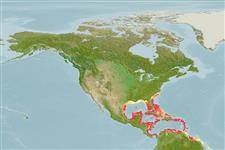| Native range | All suitable habitat | Point map | Year 2100 |

|
| This map was computer-generated and has not yet been reviewed. |
| Agonostomus monticola AquaMaps Data sources: GBIF OBIS |
Length at first maturity
Lm 16.6, range 12 - ? cm
Human uses
Fisheries: subsistence fisheries
Phylogenetic diversity index
(Ref. 82805)
PD50 = 0.6250 many relatives (e.g. carps) 0.5 - 2.0 few relatives (e.g. lungfishes)
Trophic Level
(Ref. 69278)
2.5 ±0.2 se; Based on size and trophs of closest relatives
Resilience
(Ref. 69278)
High, minimum population doubling time less than 15 months (Fec = 128,827)